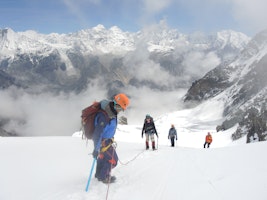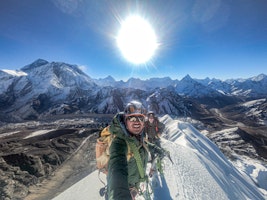There are plenty of reasons to visit Nepal, and of course, the Himalayas are one of them. However, mountaineering in Nepal is special not only because of the sheer size of the mountains, and the variety of peaks to explore and climb but also due to the unique mountain culture and color. Prayer flags, tiny mountain villages, sherpas and yaks, remote temples, and blooming rhododendrons all crown the unique experience of trekking and mountain climbing in Nepal.
Below we share with you our Himalayas Nepal guide with a selection of the top 10 trekking and mountaineering options in the Himalayas. The season to go is before or after the monsoon, that is to say from April to June or September to November. Keep in mind that going with an IFMGA or NNMGA certified mountain guide (keep in mind that the IFMGA and NNMGA certifications are the most serious and the ones to look out for) to ensure safety and help with logistics. Additionally, joining a group is a feasible option that will make the climbing experience more enjoyable and also cheaper.
Trekking in Nepal
Trekking is a great option for those who would like to explore and enjoy an outdoor adventure in the Himalayas but don’t have the technical skills or high mountain experience to actually climb to a Himalayas summit. Nepal is famous for its treks, and the ones listed here are our favorite, but by no means the only Nepal treks you can enjoy.
1. Annapurna Base Camp Trek (ABC Trek)
 Nepal guide ABC trek
Nepal guide ABC trek
ABC Trek- Photo courtesy of Jyamchang
The Annapurna massif in north-central Nepal is one of the trekking hotspots of the Himalayas. Although the Annapurna Circuit Trek has been voted one of the best long-distance treks in the world, the Annapurna Base Camp Trek is just as gorgeous but less strenuous. Because it is shorter and takes you to a lower altitude, it is the perfect fit for hikers with little experience but a good fitness level.
Average duration: 2 weeks
Starting point: Nayapul
Highest point: Annapurna Sanctuary (4,130 m)
Difficulty: Moderate
Highlights:
You get an in-depth view of the local culture and villages.
Amazing Himalaya landscapes.
Easier than Everest Base Camp.
We recommend: Annapurna Base Camp 11-day Guided Hiking Tour
2. Poon Hill Trek
 Nepal Guide Poonhill
Nepal Guide Poonhill
Photo courtesy of Scenic Nepal
Also in the Annapurna region, the shorter and easier Poon Hill trek takes you to the amazing viewpoint on Poon Hill. This unique spot allows you to catch 360-degree views of the surrounding mountains, plus, it is a gorgeous place to enjoy a unique sunrise.
Average duration: 1 to 2 weeks
Starting point: Nayapul
Highest point: Poon Hill vantage point at 3210 m
Difficulty: Because you will spend several hours each day trekking you will need a good fitness level.
Highlights:
Catching sight of the sunrise from Poon Hill
Traversing through the Annapurna region
Enjoy amazing 360-degree views of the Himalayas
We recommend: Easy 8-day Poon Hill Trek
3. Everest Base Camp (EBC Trek)
 Nepal Guide EBC trek
Nepal Guide EBC trek
EBC Trek- Photo courtesy of Jyamchang
The EBC Trek is a classic, but it’s more intense than the ABC trek, so some prior experience is mandatory. This trek takes you through the northeast of Nepal to the heart of the Mahalangur Himal section of the Himalayas, where Everest is located. Although you won’t reach the summit of the world’s highest mountain on a trekking adventure, you will get a taste of the local and mountaineering culture that Everest embodies.
Average duration: 2 weeks
Starting point: Lukla
Highest point: Everest Base Camp (5,364 m) 17,598 feet
Difficulty: Intermediate
Highlights:
Discover the Everest mountain culture.
Explore an emblematic region of the Himalayas
Train for more difficult climbs
We recommend: 16-day Everest Base Camp guided trek
4. Kanchenjunga Trek
 Nepal guide Kanchenjunga
Nepal guide Kanchenjunga
Photo courtesy by GuideSource
Kanchenjunga is located in the eastern Himalayas, between Nepal’s Taplejung District and India. At 8,586 m (28,169 ft), Kanchenjunga, which translates to “the five treasures of the high snow”, is the third highest mountain in the world and a truly challenging one to climb, harder than Everest. However, shorter treks in the region are also an option.
Trekking in the Kanchenjunga Himal range is a great way to explore the area, renowned for its natural beauty, flora, and fauna, as well as for its unique culture. Kanchenjunga treks are long and physically demanding but well worth it if you are looking to delve into a remote location full of rewarding surprises.
Average duration: 3 weeks
Starting point: Tapeljung (also known as Suketar)
Highest point: It depends on the program.
Difficulty: Non-technical but physically demanding
Highlights:
Explore a remote spot in the Himalayas.
Discover amazing flora and fauna.
Enjoy the influences of Tibetan cultures in the mountain towns on the way.
We recommend: 22-day Kanchenjunga Base Camp Trek
Mountain Climbing in Nepal
The objective of a mountain climbing expedition differs from that of a trek in that the ultimate goal is to reach a mountain summit, and the demands are a bit different. Of course, with some of the highest mountains in the world located in the Himalayas, it makes sense that Nepal is such a hotspot for mountaineering. However, keep in mind that altitude, weather, and technical challenges are demanding, and therefore, actually reaching the summit is not a given. On the bright side, Nepal is so gorgeous that it will be worth it regardless, and when you do reach the top, can you imagine what the world looks like below? Choose your mountain, plan your trip, and find out!
5. Mera peak
 Nepal Guide Mera Peak
Nepal Guide Mera Peak
Photo courtesy of Tshering
Climbing Mera Peak is a great option for beginner climbers, although a good fitness level and acclimatization are necessary to tackle it. Mera is located in the Sagarmatha Region of Nepal. There are several routes to climb it, the north route is the most commonly climbed and it includes high-altitude glacier walking. The west and south faces are perfect for more advanced mountaineers looking for more technical routes. One of Mera’s highlights is that from the summit you can enjoy 360-degree panoramic views of Everest, Kanchenjunga, Lhotse, Makalu, and Cho Oyu, which are some of the world’s highest mountains.
Altitude: 6,476 m (21,247 ft)
Average duration: 16 to 25 days
Starting point: Lukla
Difficulty: basic mountain climbing skills required (Grade PD)
Highlights:
Catching sight of 5 of the world’s highest mountains from the summit.
An accessible climb for beginner mountaineers.
The option of climbing more technical routes for more advanced mountaineers.
We recommend: Mera Peak 19-day Guided Climb.
6. Lobuche
 Nepal Guide Lhotse
Nepal Guide Lhotse
Photo courtesy of Tshering
Lobuche is located near Khumbu Glacier, which lies between Mount Everest and the Lhotse-Nuptse Ridge. Two peaks, east and west, make up this mountain. Lobuche east is considered a trekking peak-though more technical than others-, and a great training mountain, while Lobuche west is considered an expedition peak. Consequently, the difficulty varies depending on which of the two you decide to tackle.
Altitude: East: 6,119 m (20,075 ft)West: 6,145 m (20,161 ft)
Average duration: 2 to 3 weeks
Starting point: Lukla
Difficulty: Intermediate
Highlights:
A great training and acclimatization option.
Beautiful views of the Everest region.
Lobuche East is the most technical trekking peak in Nepal
We recommend: This amazing combined program which will take you to Everest Base Camp and the Lobuche East summit.
7. Ama Dablam
 Nepal guide Ama Dablam
Nepal guide Ama Dablam
Photo courtesy of Tshering
Ama Dablam is a favorite among Explore-Share users, and for good reason. Due to its shape, its name translates to “mother’s necklace” but it also sometimes referred to as the “Matterhorn of the Himalayas”. Located in the Khumbu region, in northeast Nepal, it is one of the most popular mountaineering peaks in the country and is usually climbed via the Southwest Ridge.
Altitude: 6,812 m (22,349 ft)
Average duration: 1 month
Starting point: Lukla
Difficulty: Technical, for advanced mountaineers
Highlights:
The hanging glacier.
The mountaineering challenge.
Explore the amazing Khumbu region and Nepalese culture.
We recommend: The best-selling 5 Peaks Technical Climbing Course + Ama Dablam ascent.
READ MORE ABOUT climbING Ama Dablam AND START PLANNING YOUR ADVENTURE.
8. Himlung Himal
 Nepal Guide Himlung Himal
Nepal Guide Himlung Himal
Photo courtesy of JyamchangHimlung Himal is located in the Manaslu region, close to the border with Tibet, northeast of the Annapurna region. It’s an ideal climb for those looking to try a 7k objective without big technical challenges. Additionally, climbing Himlung is a great way to explore more remote towns in Nepal, as well as truly diving deep into the Himalayan wilderness.
Altitude: 7,140 m (23,430 ft)
Average duration: 1 month
Starting point: Kathmandu
Difficulty: High-altitude, semi-technical, graded 3D
Highlights:
Catch sight of amazing sunrises and sunsets.
Visit remote villages of Nepal near the Tibetan border.
Spend a full month mountaineering on a 7k peak in Nepal.
We recommend: Himlung-Himal 27-day Expedition in the Himalayas.
9. Manaslu
 Nepal Guide Manaslu
Nepal Guide Manaslu
Photo courtesy of Anastasiya
Manaslu, the “mountain of the Spirit”, is the eighth highest mountain in the world. It is located in west-central Nepal, in the Manaslu Himal subrange of the Himalayas. Its amazing glacial valleys and long ridges offer several climbing routes for mountaineers. Although this is the “easiest” 8-thousander to climb, it is still a very testy mountain that requires well-trained mountaineering skills. Also, keep in mind that pre and post-monsoon are the Himalaya climbing season, however, September is optimal for Manaslu.
Altitude: 8,163 metres (26,781 ft)
Average duration: 35-60 days
Starting point: Kathmandu
Difficulty: Hard
Highlights:
Climbing one of the Himalayas ‘ 8-thousand meter peaks.
Exploring the stunning Manaslu region and views.
Trekking through some of the Nepalese villages and discovering the local culture.
We recommend: 40-day Manaslu Summit expedition.
10. Everest
 Nepal Guide Everest
Nepal Guide Everest
Photo courtesy of Tshering
Mount Everest, the tallest mountain in the world can be climbed, but not easily. However, IFMGA guide, Tshering, has summited this amazing mountaineering icon several times and successfully guided people to the top. Experience and training are a must, and some paperwork too. That said, if summiting the summit of summits is on your bucket list, then by all means do. You can read all about considerations for climbing Everest here and we’ll help you find the best guide.
Altitude: 8,848.86 m (29,031.7 ft)
Average duration: 2 months
Starting point: Lukla
Difficulty: Extremely hard
Highlights:
Climbing the world’s tallest mountain.
Putting your mountaineering skills and experience to the test.
Achieving an amazing feat in the breathtaking Himalayas.
We recommend: Mount Everest Guided Expedition from Nepal.
Are you thinking of traveling to Nepal to experience the unique Himalaya mountain culture? Then pick a guide and start preparing for an adventure you will never forget. We will help you have the trip of a lifetime!







